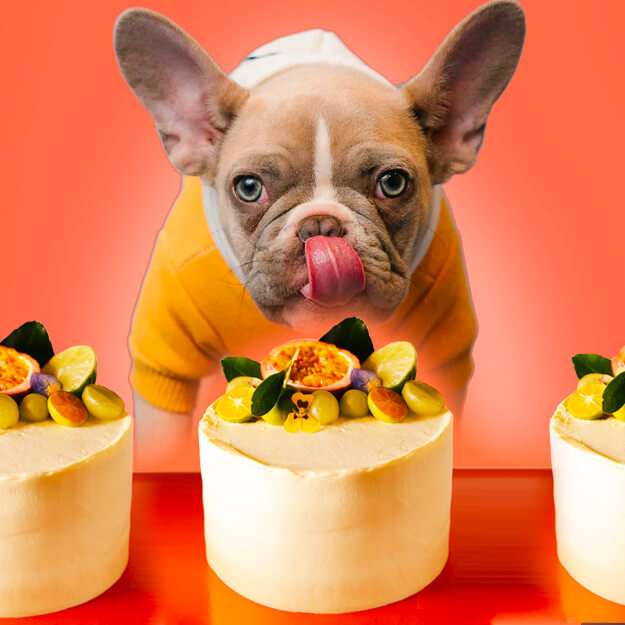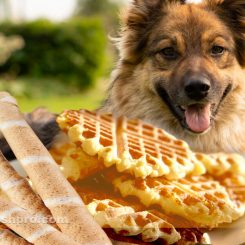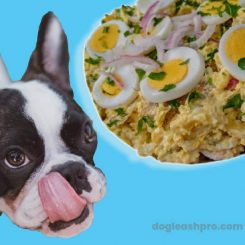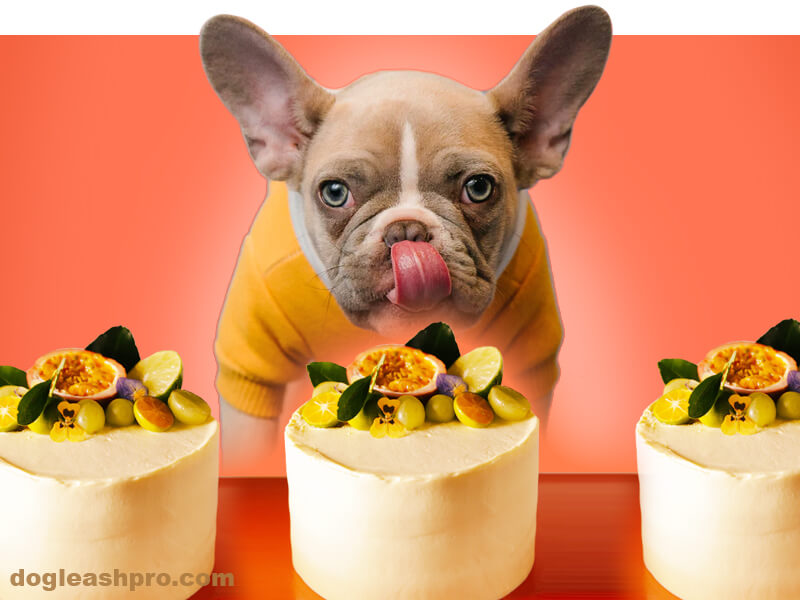
Can dogs eat Custard? Yes, dogs can eat Custard only if it’s a small amount without any flavoring like vanilla or chocolate. While Custards aren’t toxic, they do contain a list of ingredients that are not safe for your dog’s health. If your dogs eat too many Custards, they can gain weight, have an upset stomach, and potentially suffer dental problems.
Custard, like Sour cream, is made for human consumption. It comes in many different types and you’re probably consuming one right now. Your canine friends are probably sitting next to you and giving you those puppy eyes.
You’re reading this because you’re probably wondering, “Can my dog eat Custard?” and if the Custard in your hand is safe for your dog to eat. Let’s go over the details now before you allow your pup to lick the Custard off of your hand.
Table of Contents
Can dogs have Custard?
Dogs can have a small amount of Custard, but it is not recommended as a regular treat.
That’s because Custard typically contains sugar and dairy products, which can be difficult for some dogs to digest and this can lead to gastrointestinal issues.
The amount of sugar found in your typical store-bought Custard can vary depending on the brand and serving size.
Typically, you can expect around 15 to 25 grams of sugar per 100-gram serving. This is a lot of sugar for our small pups.
Frequent sugar consumption can lead to canine obesity and dental problems in dogs.
Therefore, before you offer Custard to your furry friends, be sure to check the nutritional label on the packaging first to find out how much sugar it contains.
What is Custard?
Much like Fortune cookies, Custard is a sweet dessert or snack. It varies in consistency and flavor. Some Custards are in the form of thick pastry cream while other Custards are in the form of thin sauce. Most Custards are vanilla-flavored.
There are different types of Custards including:
- Baked Custard.
- Pastry cream Custard.
- Powdered Custard.
- Refrigerated Custard.
- Stirred Custard.
- Ultra-heat-treated (UHT) Custard.
- Egg Custard.
What is in Custard?
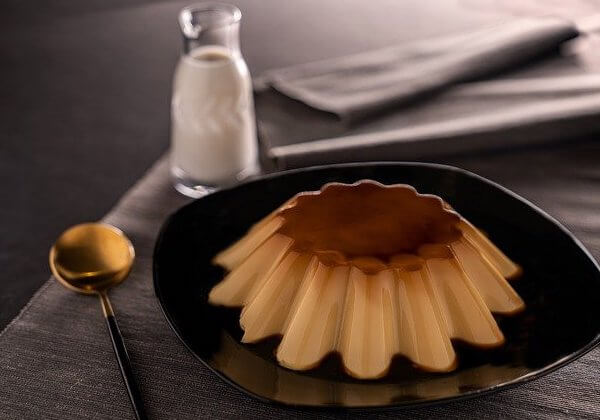
Although there are many different recipes for Custard, many Custards share the same common ingredients:
- Cream or sweetened milk.
- Cheese.
- Eggs and egg yolks.
- Sugar.
- Flavorings like vanilla.
Some people like to include thickening starch such as flour, arrowroot, corn starch, potato starch, or gelatin.
READ ALSO: Can Dogs Eat Jello? Complete Guide to Dogs & Gelatin
However, it isn’t necessary because egg yolks and whole eggs are usually the main thickeners in many Custard.
Let’s discuss each of these ingredients:
Caster sugar (Not recommended for dogs)
While natural sugars from fruits are safe for dogs to consume, caster sugar is not. Dogs with a diet that is high in sugar will be at risk for dental problems, diabetes, and obesity. In addition to caster sugar, make sure to also avoid candies or desserts that are loaded with sugar and artificial sweeteners. They are also toxic to dogs.
Risks of caster sugar:
- Dental problems (Cavities in teeth)
- Diabetes
- Weight gain
- Depression
Double cream (Not recommended for dogs)
Some dogs that are lactose intolerant will have a hard time digesting dairy products. The milk in the cream is also not recommended for dogs.
Risks of cream:
- Upset stomach
Whole milk (Not recommended for dogs)
When dogs consume dairy products, they could get the following symptoms:
Risks of whole milk:
- Vomiting
- Diarrhea
- Upset stomach
Egg yolks (Safe for dogs)
Eggs are safe for dogs as they are high in protein, nutritious, and have amino acids. Keep in mind that dogs should only have a small number of eggs.
Benefits of egg yolks:
- Provides fatty acids, protein, and amino acids to dogs
- Help calm upset stomach
- Source of calcium
Risks of eggs:
- If consumed too much, dogs may have high cholesterol and gain weight
- Risk of salmonella if you feed raw eggs to dogs
Corn flour (Safe for dogs)
Corn flour is safe for dogs. Some dog food has corn flour in it and you may not even be aware. It is used to thicken the ingredients and mostly used in baking. Corn flour does not provide any nutritional benefits to dogs.
Vanilla Extract (Not recommended for dogs)
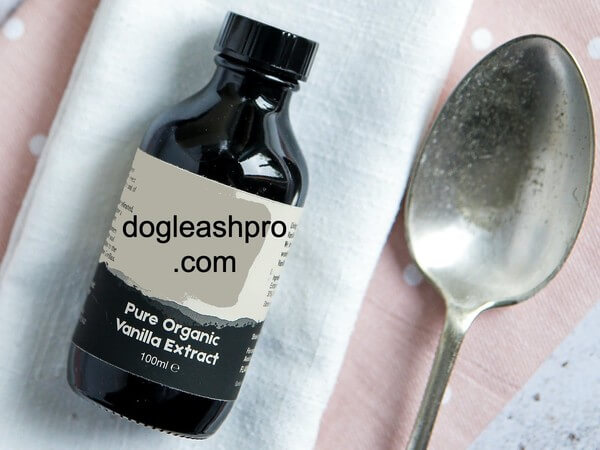
Vanilla extract contains a high amount of alcohol. Your dog’s digestive system may not be able to properly break down the alcohol. Dogs that consume food with a lot of vanilla extract are at risk of alcohol poisoning. Try to use alcohol-free vanilla extract instead so it’s safe for your pup.
Risks of vanilla extract:
- Upset stomach
- Trouble breathing
Butter (Not recommended for dogs)
While butter is not harmful to dogs, it doesn’t provide any nutritional benefits to dogs and it is also high in fat. Butter contains dairy products so your dogs may have a difficult time digesting the butter especially if they are lactose-intolerant.
Risks of butter:
- Obesity
- Upset stomach
Is Custard bad for dogs?
Custard is bad for dogs if your pooch consumes too much of it. The key here is the tastier the Custard, the more dangerous it is to your pup. For example, a creamy rich taste Custard is considered more delicious than a low-fat Custard. But did you know it has about 6%
Since Custard contains dairy products such as milk and cream, it is generally not safe for dogs.
Here are a few reasons why you should rethink giving Custard to your furry friends:
Most dogs are lactose intolerant
Most canines are lactose intolerant which means they don’t have enough of the enzyme lactase that is responsible for breaking down the lactose in milk or cream. Thus, they are not able to properly digest milk or cream.
If your dog accidentally ate a little bit of Custard, don’t sweat it. But you should keep the Custard away from your dog’s reach.
If your pooch accidentally ate a lot of Custard, contact your veterinarian right away. Eating a lot of Custard means your furry friend has consumed too much milk and this will lead to the following symptoms:
- Bloating.
- Constantly passing gas.
- Diarrhea.
- Loose stools.
- Vomiting.
- Abdominal pain.
Danger of Sugar
Custard tastes good because it contains sugar. However, too much sugar can be dangerous to your canine’s health causing weight gain, dental problems, and diabetes.
Periodontal disease is very common in dogs. In fact, 80% of dogs develop dental issues by the time they reach 3 years old. So let’s be careful and not let Custard contribute to this already common and serious health problem in dogs.
If you’re giving just a small amount of Custard to your dogs, then they should be fine as very little sugar is not harmful to your pup. It’s alright to give Custard to your four-legged friends as an occasional treat every few months.
Danger of Flavoring

If the Custard has chocolate flavoring, please do not give that Custard to your pooch. Chocolate is very dangerous to dogs and it also contains theobromine and caffeine. Both of these substances can cause toxicity in dogs. Also, the darker the chocolate, the greater the toxicity level for your pooch.
How do I make Custard for my dog at home?
If your pup is eyeing your Custard and you feel guilty for not sharing it, don’t worry. You can make the Custard yourself. Here’s what you can do.
Use the following canine-friendly Custard ingredients:
- ½ teaspoon of salt.
- 3 tablespoon of cornflour.
- 2 egg yolks.
- ½ can of evaporated milk with water to make half a liter.
- 1 teaspoon of vanilla.
Dogs and Custard
Dogs and Custards do not make an ideal combination, as not all types of Custard are safe for doggy consumption.
There are various types of Custard, including traditional, flavored (like chocolate or vanilla), and instant.
Some of these Custards may contain harmful ingredients, such as chocolate or artificial sweeteners, which can be toxic to our furry friends and cause severe health issues.
Below, we will list the different types of Custard you can find at your local grocery stores or supermarket and discuss whether they are safe for canine consumption.
Can dogs eat frozen Custard?
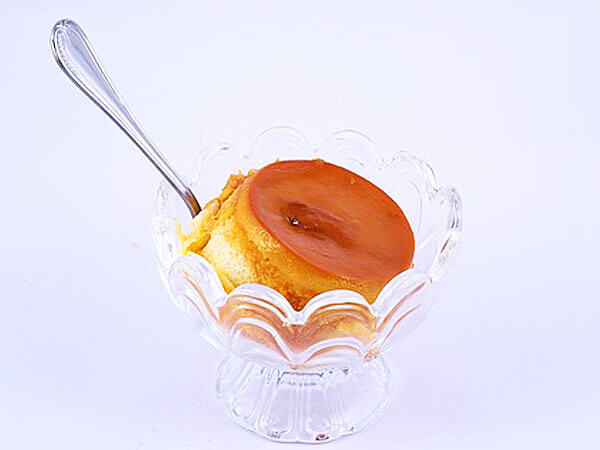
No, dogs should not eat frozen Custard. Whether it is frozen or not, Custard contains several ingredients, namely sugar, flavorings, and milk that are very toxic to dogs.
Can dogs have vanilla Custard?
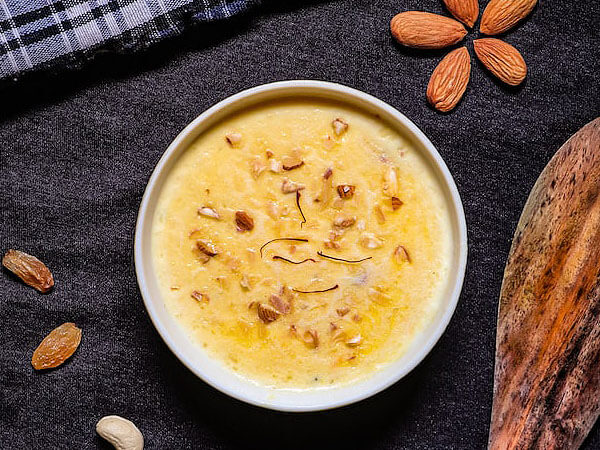
No, dogs should not have vanilla Custard as a regular treat due to potential adverse effects on their health.
Not only does vanilla Custard contain a significant amount of sugar (typically around 15 to 25 grams of sugar per 100-gram serving depending on the brand), but also it often contains artificial flavorings or additives that may not be safe for K9 consumption.
Furthermore, the high-calorie content in Custard can contribute to weight gain, dental problems, gastrointestinal issues, and other related health problems in dogs, making it an unsuitable treat option.
It’s best to stick to dog-specific treats and avoid giving vanilla-flavored human foods to your precious pups. But, if you must, you can give just a small amount as an occasional treat.
Can dogs have vanilla frozen Custard?
When it comes to the question, “Can dogs eat vanilla frozen custard?” the answer is that it’s not a suitable treat for dogs.
Whether the Custard is frozen or not, it still contains dairy products and sugar, which can be difficult for dogs to digest and may cause gastrointestinal issues.
That’s because our four-legged friends lack the lactase enzyme that breaks down lactose, the sugar in milk and other dairy products.
When the lactose is not adequately broken down in a dog’s digestive system, it can cause symptoms such as diarrhea, gas, bloating, and vomiting.
Additionally, the high-calorie content of vanilla frozen Custard can contribute to weight gain and related health problems in dogs.
Thus, it is best to provide dog-specific treats designed for their nutritional needs and avoid sharing human desserts like vanilla frozen custard with them.
Can dogs have Custard ice cream?
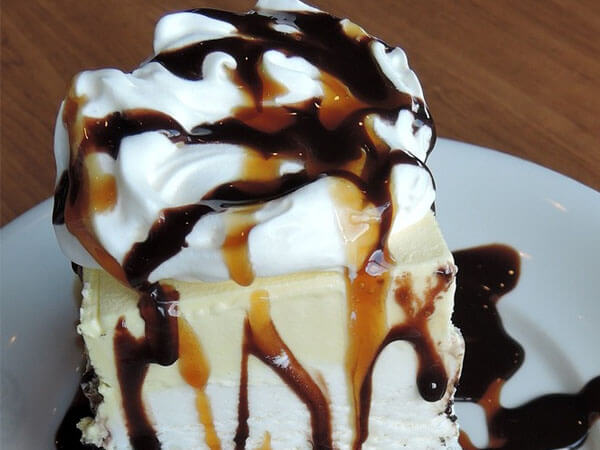
No, dogs should not eat Custard ice cream as it contains toxic ingredients to dogs like flavoring, sugar, and milk. Custard ice cream also has a lot of sugar which is not great for your dog’s health.
Additionally, it is a dairy product so your pup may have a hard time digesting it. Your pooch may experience symptoms such as an upset stomach, diarrhea, and may vomit.
Can dogs eat coconut Custard pie?
No, dogs should not eat coconut Custard pie, as it is not a suitable treat for them.
Coconut Custard pie typically contains ingredients that can be harmful to dogs, such as high sugar content, and it may also include other unsafe components like xylitol, an artificial sweetener.
Also, some coconut Custard pies may contain a common spice called nutmeg. Nutmeg has myristicin, which can cause disorientation, hallucinations, increased heart rate, and seizures in dogs.
Providing dog-specific treats that cater to their nutritional needs is a better option to ensure their well-being.
Can dogs eat Custard apples?
If you’re wondering, “Can dog eat custard apple?” the answer is no, dogs should not eat Custard apples. If your furry friend accidentally swallows a few seeds, that could be dangerous.
Make sure to keep an eye on him. If he’s experiencing symptoms, contact your vet immediately. Make sure your pooch is hydrated after accidentally eating Custard apples.
Can dogs eat Custard tarts?
No, dogs should not eat Custard tarts. They are high in sugar which is not good for your dog’s health. In fact, your pooch may experience an upset stomach from eating Custard tarts.
Can dogs eat egg Custard tarts?

While egg Custard tart may sound healthy, it really isn’t. At least not to our furry friends. Our four-legged friends should not eat egg Custard tarts because of these two main reasons:
- High sugar content: Egg Custard tarts usually contain a significant amount of sugar, which can lead to obesity, dental issues, and diabetes in dogs when consumed regularly or in large quantities.
- Dairy products: These tarts contain dairy products like milk or cream, which can be difficult for dogs to digest due to their limited lactase production. This could result in gastrointestinal issues such as diarrhea, gas, bloating, and vomiting.
Can dogs eat Custard cream biscuits?
No, dogs should not eat Custard cream biscuits. Custard cream biscuits are a famous British sandwich cookie consisting of a vanilla-flavored custard filling between two biscuit layers.
They originated in the United Kingdom and have been a favorite teatime treat for many generations.
Regarding dogs eating Custard cream biscuits, it is generally discouraged.
These biscuits are high in sugar, which may lead to weight gain, dental problems, and potential diabetes in dogs.
The Custard filling often contains dairy, which can cause digestive difficulties in dogs due to their limited lactase production.
Can dogs eat Custard creams?
No, dogs should not eat Custard creams. Similar to Custard ice cream, it has a lot of sugar which can cause depression, agitation, and hyperactivity in dogs in the short term.
Over the long run, your pup may experience serious health problems including dental problems, diabetes, and obesity.
Can dogs eat Rita’s Custard?
No, dogs should not eat Rita’s Custard. Rita’s Custard is a restaurant and Custard brand. If you bring your dogs with you to Rita’s Custard, they may offer a pup cup to your furry friends.
Can dogs eat Culver’s Custard?
No, dogs should not eat Culver’s Custard. Instead of Culver’s Custard, the restaurant does offer dog biscuits and dog-friendly ice cream with a milk bone. So get these instead of the Custard.
Canine-friendly alternatives to Custard
If you’re not sure what ingredients are in the Custard you’re eating, avoid giving it to your dog. Instead, here are some safe canine-friendly desserts to give your four-legged friends:
Homemade fruit popsicles
Instead of Custard, you can make frozen fruit popsicles yourself. This way, you know what is in these flavorful treats. You can use pumpkin, peanut butter that is xylitol-free, and mashed bananas with either low-fat plain yogurt or chicken broth that is low sodium.
Freeze them for 2 to 3 hours and let your pooch enjoy this healthy homemade snack.
For creamy cold dog treats, we prefer to give our pups this:
What if my dog accidentally ate a lot of Custard?
If your pooch accidentally ate a lot of Custard in a short amount of time, don’t freak out. Monitor him closely for the next several hours. Look into the ingredient of the Custard he just ate.
If he is not lactose intolerant and there aren’t any toxic ingredients in the Custard, then your furry friend should be fine.
If he’s lactose-intolerant and there’s also chocolate or xylitol in the Custard, then you need to bring him to the vet as soon as possible.
Visiting the vet is especially crucial if your dog’s body temperature is rising and his body is visibly shaking. Some dogs may even vomit or have diarrhea.
So, can dogs eat Custard?
It is best not to give Custard to your four-legged friends. Make sure to give them healthy snack alternatives instead of Custard.
Related Questions:
No, dogs should not eat Custard pie if it contains the following harmful ingredients: milk, sugar, and flavoring.
DISCLAIMER: THIS WEBSITE DOES NOT PROVIDE MEDICAL ADVICE
The information, including but not limited to, text, graphics, images and other material contained on this website are for informational purposes only. No material on this site is intended to be a substitute for professional veterinary advice, diagnosis, or treatment. Always seek the advice of your veterinarian or other qualified health care provider with any questions you may have regarding dietary needs.
Resources:
https://www.petmd.com/dog/slideshows/6-reasons-why-your-dog-shouldnt-have-sugar#slide-1
https://www.akc.org/expert-advice/health/diabetes-in-dogs/

With over five years of specialized experience as an animal writer, my expertise lies in dog nutrition, health, behavior, grooming, and training. I am dedicated to delivering helpful and informative content that caters to the well-being of our furry friends. My primary goal is to empower pet owners with knowledge and ensure our canine companions thrive in health and happiness. In my free time, I love volunteering at local dog rescue centers.
